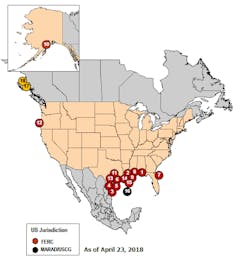Will LNG Microgrids Find a Ready Market in Puerto Rico?
For all its electricity struggles – or rather because of them – Puerto Rico has become a rich, primordial soup for energy innovation. The latest to emerge are LNG microgrids.
A combination of liquefied natural gas (LNG), renewables and energy storage, the product is now being offered on the island by Southern Company’s subsidiary PowerSecure and Florida-based Crowley Fuels.
Diesel generators have been a mainstay grid backup, but after supplies ran low following Hurricane Maria, energy planners have sought alternatives. As the PowerSecure and Crowley team see it, LNG can add more gas generators to the mix.
“As customers in Puerto Rico and other markets consider energy solutions, LNG microgrids provide resilient operations with cleaner, dependable fuel that they can develop to meet diverse industry needs alongside traditional utility services,” said Crowley’s Greg Buffington, vice president, LNG.
Converting North America’s plentiful supply of natural gas into liquid form – so that it can be transported – is a growing business. LNG exports quadrupled to 1.94 billion cubic feet per day (Bcf/d) in 2017 from 0.5 Bcf/d in 2016, according to the U.S Energy Information Administration.
The rise in LNG use tracks an overall increase in U.S. gas exports. While most is piped in gaseous form to Canada and Mexico, its liquid form is gaining market share with the opening of new LNG export facilities at ports.
For microgrid use, LNG is vaporized back into natural gas. In Puerto Rico, the partnership will focus on LNG microgrids for commercial, industrial and municipal operations. But the companies also see potential elsewhere.
“We are looking forward to providing our highly resilient, sustainable industry-leading microgrids to serve industrial and commercial customers in Puerto Rico and throughout the Caribbean and Central America,” said Mark Martyak, chief sales officer, PowerSecure Distributed Infrastructure.
PowerSecure is well-versed in microgrids. Acquired by Southern Company for $431 million in 2018, the company has install 2.5 GW of microgrid capacity (fossil fuel, solar, fuel cell and energy storage). GTM Research credits 41 percent of microgrid capacity in the U.S. to PowerSecure.
The partnership has yet to build any LNG microgrids on the island. But Crowley has a foothold, delivering 32 MW of LNG supply contracts in Puerto Rico since 2014. Crowley has more than 98 million gallons of LNG storage available near its terminal in Jacksonville, Fla. Additional storage capacity in Puerto Rico is under development.
Still the introduction of the LNG microgrid to U.S. territory is not a slam dunk. As a fossil fuel, LNG has faced opposition from environmental groups like the Sierra Club, which has attempted to block construction of LNG export facilities.
EIA lists three export facilities now in operation in Arkansas, Louisiana and Maryland. Another dozen have won approval and 18 have been proposed, most in the U.S. Southeast, including one in Jacksonville, Florida, proposed by Eagle LNG.
Proposed LNG Export Terminals: US EIA
Cathy Kunkel, an energy analyst with the Institute for Energy Economics and Financial Analysis, sees places in Puerto Rico where LNG microgrids may make sense and places they may not.
“My main concern would be the ability to get LNG to these microgrids in the event of a sustained emergency, such as that caused by hurricane Maria,” said Kunkel, who has worked as an energy advisor on the island. “Shipping LNG to Puerto Rico in ISO containers would get you access to LNG at some of the smaller ports around the island, but if you had a gas-based microgrid in a remote area, you’d still have to get the natural gas there. That would raise reliability concerns if roads are blocked for a long period.”
She added, however, that LNG microgrids could make sense “to use LNG for CHP [combined heat and power] installations in coastal areas that are near ports. My main question, again, is how viable this is the further you get from a port.”
Track news about LNG microgrids — and all types of microgrids — by subscribing to the Microgrid Knowledge newsletter. It’s free.
About the Author
Elisa Wood
Editor-in-Chief
Elisa Wood is the editor and founder of EnergyChangemakers.com. She is co-founder and former editor of Microgrid Knowledge.
